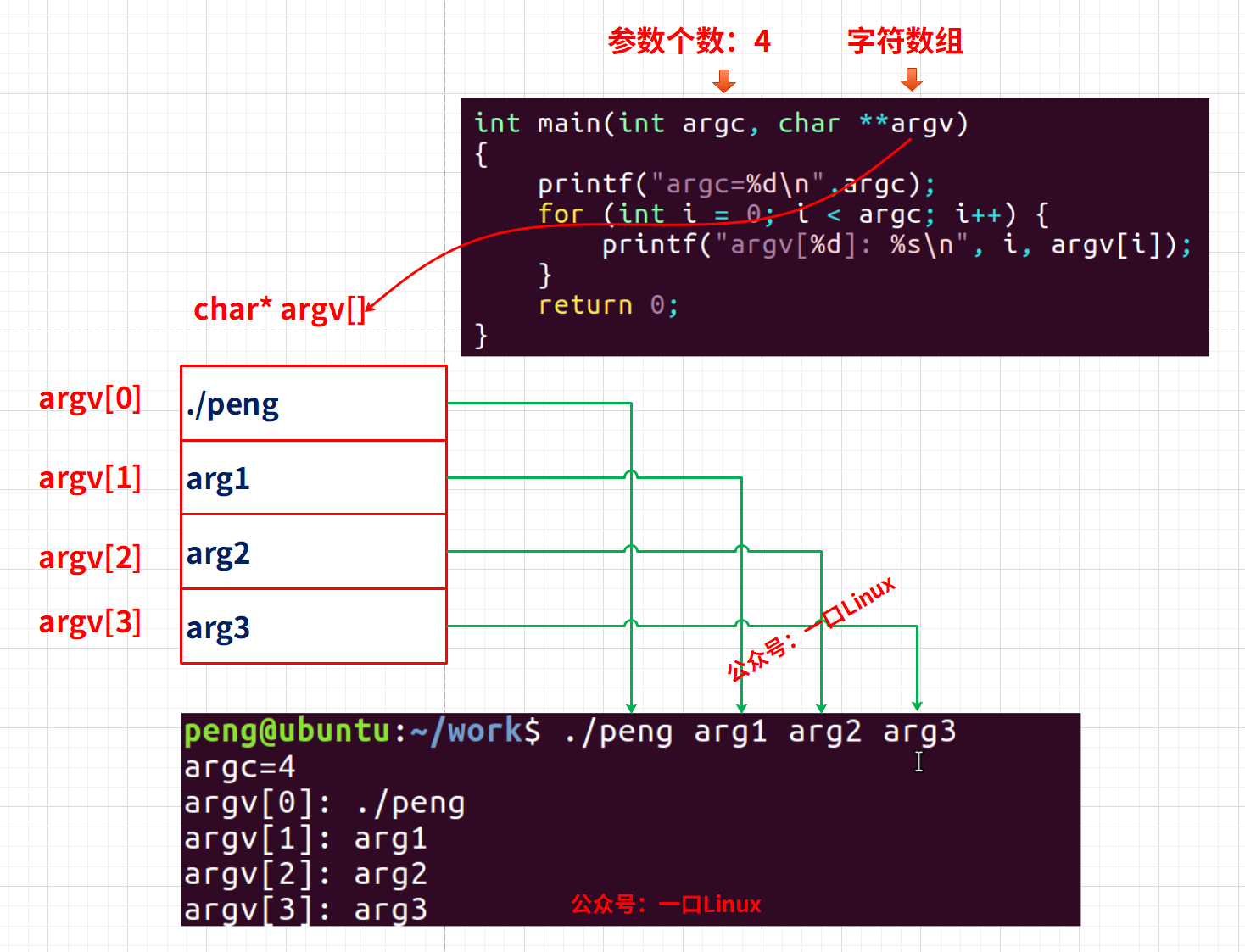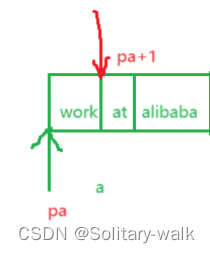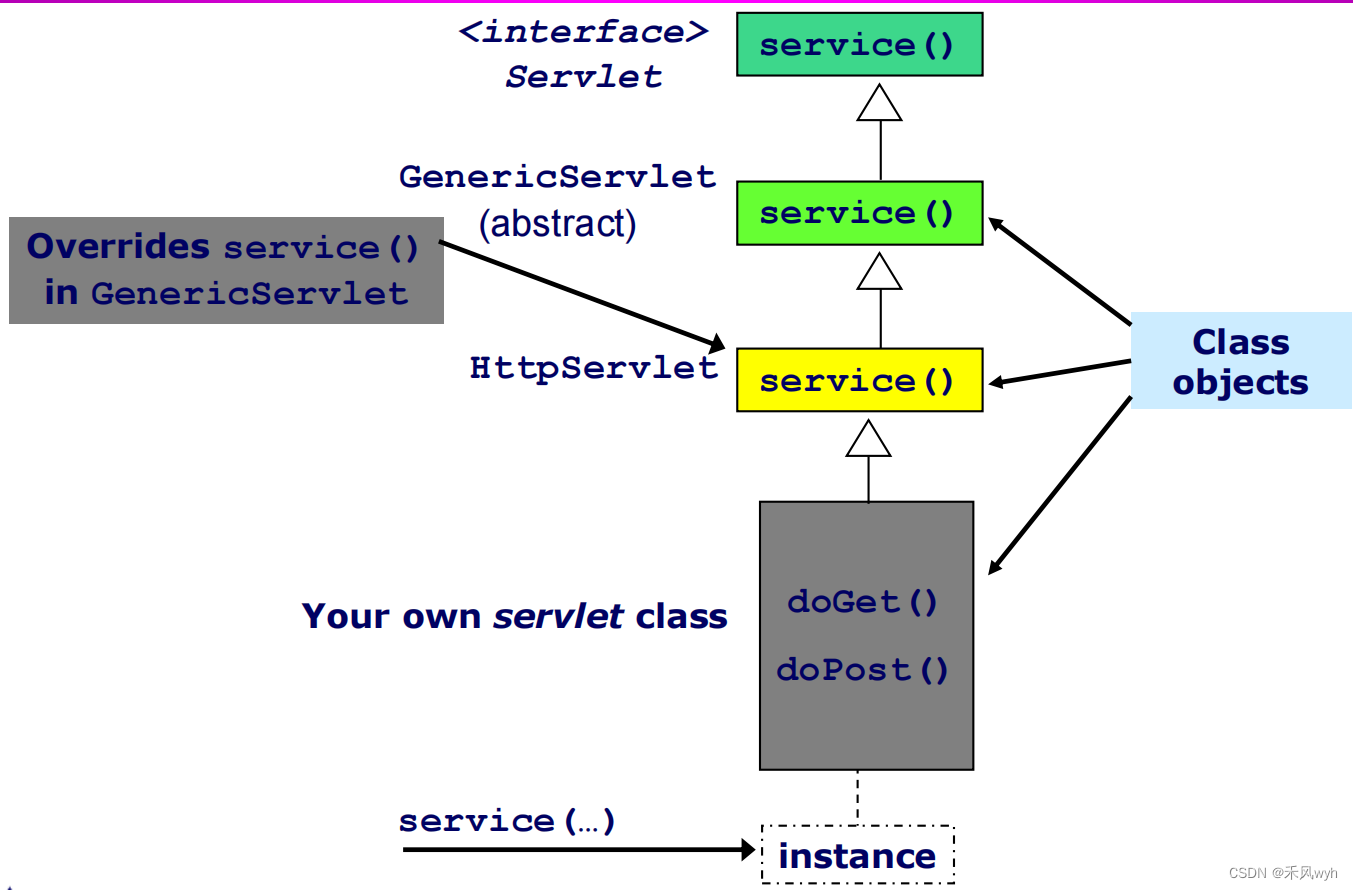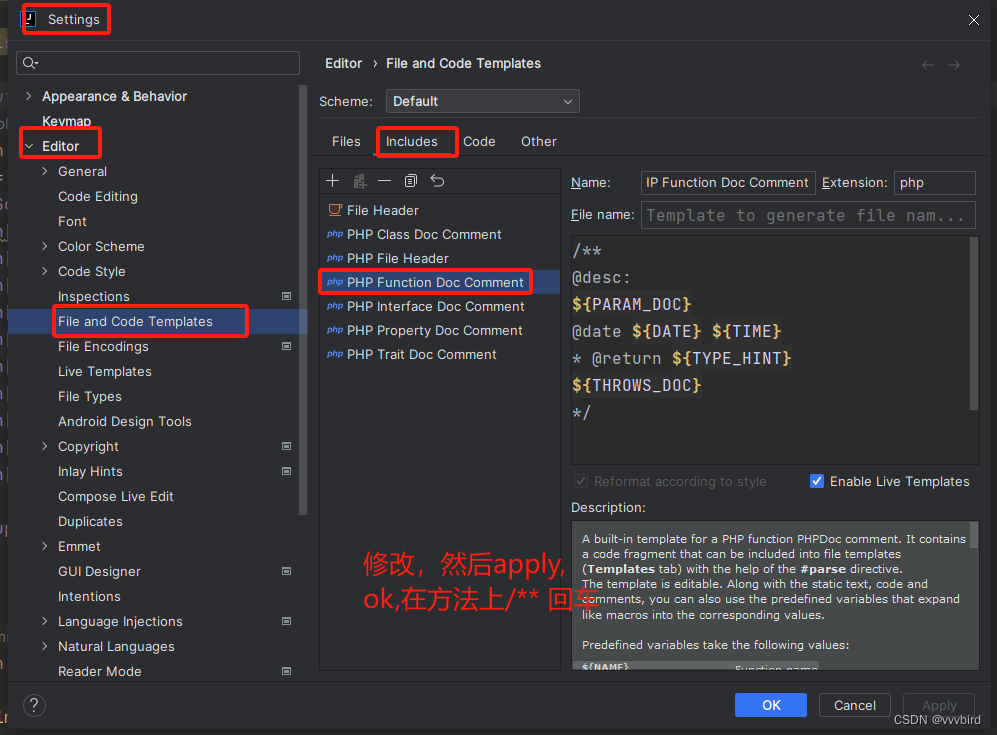一、linux应用程序如何接收参数?
1. argc、argv
Linux应用程序执行时,我们往往通过命令行带入参数给程序,比如
ls /dev/ -l
其中参数 /dev/ 、-l都是作为参数传递给命令 ls
应用程序又是如何接收这些参数的?
通常应用程序都是从main函数开始执行,传统的main函数风格如下:
int main(int argc, char* argv[])
argc:
程序的命令行参数的数量,用于统计参数数量。
argv:
是一个指向一个字符串数组的指针,数组包含了参数,每个字符串就是一个参数,最后一个元素为0。
过一般习惯使用多级指针来操作字符串。
*char argv[]有时候我们也写成char argv,
**argv[]**是一个存放字符类型元素地址的数组。
因为 C 中是有字符串的概念的:将每个字符存放在 char 数组,最后一个元素为**\0**表示字符串的结束。
**printf(%s)**就是输出字符串。
并且一般使用argv指针来访问、处理argv[]数组的内容。
C语言中,数组就是一个指针加偏移量。
所以argv则是指向一个指针数组argv[]的指针,不用定义,直接可以用。
在argv[]数组中存放的的指针指向输入命令的各部分**(调用程序、选项、参数)**。
2. 举例
下面我们用一个实例来理解argc和argv
/*
* argc: 命令行参数的个数
* argv: 字符指针数组(指向各个命令行参数的字符指针所构成的数组)
*/
int main(int argc, char* argv[]) // 接收命令行参数
{printf("argc=%d\n",argc);for (int i = 0; i < argc; i++) {printf("argv[%d]: %s\n", i, argv[i]); // 遍历字符指针数组argv}return 0;
}
执行结果
peng@ubuntu:~/work$ ./peng arg1 arg2 arg3
argc=4
argv[0]: ./peng
argv[1]: arg1
argv[2]: arg2
argv[3]: arg3参数与argc,argv关系如下:

二、选项
1. 选项含义
linux程序除了上述情况以外,我们还经常会遇到一个使用方法就是选项应用,
比如:ping命令
peng@ubuntu:~/work$ ping -h
Usage: ping [-aAbBdDfhLnOqrRUvV] [-c count] [-i interval] [-I interface][-m mark] [-M pmtudisc_option] [-l preload] [-p pattern] [-Q tos][-s packetsize] [-S sndbuf] [-t ttl] [-T timestamp_option][-w deadline] [-W timeout] [hop1 ...] destination
参数含义:
-a:尝试将IP地址解析为主机名。
-A:使用响应数据包中的附加数据。
-b:允许ping广播地址。
-B:不允许ping广播地址。
-c count:设置要发送的数据包数量。
-d:使用SO_DEBUG选项。
-D:不将socket设为分离模式。
-f:向目标发送一个“强制”数据包。
-h:显示帮助信息。
-i interval:设置发送数据包之间的时间间隔。
-I interface:设置要使用的网络接口。
-l preload:设置发送的数据包数量。
-m mark:设置ping数据包的标记。
-M pmtudisc_option:设置MTU发现选项。
-n:不要将IP地址解析为主机名。
-O:启用原始输出。
-p pattern:设置数据包的模式。
-Q tos:设置服务类型。
-r:不使用路由表,直接发送数据包到目标主机。
-R:启用记录路由。
-s packetsize:设置数据包的大小。
-S sndbuf:设置套接字的发送缓冲区大小。
-t ttl:设置数据包的TTL值。
-T timestamp_option:设置时间戳选项。
-U:使用UDP数据包。
-v:显示详细的ping命令输出。
-V:显示ping命令的版本信息。
-w deadline:设置等待响应的时间。
-W timeout:设置等待响应的超时时间。destination:指定要ping的目标主机或IP地址。
这些 - 开头的都是选项,
[]表示可选的意思
[-aAbBdDfhLnOqrRUvV] 是无参的选项
[-c count] [-i interval] [-I interface]
[-m mark] [-M pmtudisc_option] [-l preload] [-p pattern] [-Q tos]
[-s packetsize] [-S sndbuf] [-t ttl] [-T timestamp_option]
[-w deadline] [-W timeout] [hop1 ...] 这些都是有参数的选项
destination 必须填写的参数
前辈们利用这点发明了“UNIX 风格”的命令,选项前面加一个横杠-,用于区分选项和参数。
2. 程序如何区分参数和选项?
在程序的代码实现中,按照 UNIX 的代码惯例,上来直接跳过第一个,然后判断指针指向的字符串第一个字符是不是-,如果是的,那么进入一个switch判断,用case列出多种支持的情况下,应该执行什么代码。
例如下面这样就可以判断选项和处理参数:
int c;
while (--argc > 0 && (*++argv)[0] == '-' {while (c = *++argv[0] {switch(c){case 'x':...break;case 'n':...break;default:printf("xxx: illegal opyion %c\n", c);...break;}}
}
3. getopt、getopt_long
事实这么处理选项参数是比较麻烦的,
linux提供了选项解析的函数:
// 头文件
#include<unistd.h>
#include<getopt.h> /*所在头文件 */
int getopt(intargc, char * const argv[], const char *optstring);
int getopt_long(int argc, char * const argv[], const char *optstring,const struct option *longopts, int*longindex);
int getopt_long_only(int argc, char * const argv[],const char *optstring,const struct option *longopts, int*longindex);
extern char *optarg; /*系统声明的全局变量 */
extern int optind, opterr, optopt;
三、getopt
1. 定义:
int getopt(int argc, char * const argv[], const char *optstring);
功能:getopt是用来解析命令行选项参数的,但是只能解析短选项: **-d 100**,不能解析长选项:**--prefix**
参数argc:main()函数传递过来的参数的个数argv:main()函数传递过来的参数的字符串指针数组optstring:选项字符串,告知 getopt()可以处理哪个选项以及哪个选项需要参数
返回:如果选项成功找到,返回选项字母;如果所有命令行选项都解析完毕,返回 -1;如果遇到选项字符不在 optstring 中,返回字符 ‘?’;如果遇到丢失参数,那么返回值依赖于 optstring 中第一个字符,如果第一个字符是 ‘:’ 则返回’:‘,否则返回’?'并提示出错误信息。
2. optstring 含义 【重要】
下边重点举例说明optstring的格式意义:
char*optstring = “ab:c::”;
单个字符a 表示选项a没有参数 格式:-a即可,不加参数
单字符加冒号b: 表示选项b有且必须加参数 格式:-b 100或-b100,但-b=100错
单字符加2冒号c:: 表示选项c可以有,也可以无 格式:-c200,其它格式错误
上面这个 optstring 在传入之后,getopt 函数将依次检查命令行是否指定了 -a, -b, -c(这需要多次调用 getopt 函数,直到其返回-1),当检查到上面某一个参数被指定时,函数会返回被指定的参数名称(即该字母)
系统声明的4个全局变量含义如下:
optarg —— 指向当前选项参数(如果有)的指针。
optind —— 再次调用 getopt() 时的下一个 argv指针的索引。
optopt —— 最后一个未知选项。
opterr —— 如果不希望getopt()打印出错信息,则只要将全域变量opterr设为0即可。
3. 实例
说千道万,不如来一个实例:
#include<stdio.h>
#include<unistd.h>
#include<getopt.h>
int main(intargc, char *argv[])
{int opt;char *string = "a::b:c:d";while ((opt = getopt(argc, argv, string))!= -1){ printf("opt = %c\t\t", opt);printf("optarg = %s\t\t",optarg);printf("optind = %d\t\t",optind);printf("argv[optind] = %s\n",argv[optind]);}
}
- 正确输入参数,执行结果如下:
peng@ubuntu:~/work/test$ ./peng -a100 -b 200 -c 300 -d
opt = a optarg = 100 optind = 2 argv[optind] = -b
opt = b optarg = 200 optind = 4 argv[optind] = -c
opt = c optarg = 300 optind = 6 argv[optind] = -d
opt = d optarg = (null) optind = 7 argv[optind] = (null)
或者
ork/test$ ./peng -a100 -b200 -c300 -d
opt = a optarg = 100 optind = 2 argv[optind] = -b200
opt = b optarg = 200 optind = 3 argv[optind] = -c300
opt = c optarg = 300 optind = 4 argv[optind] = -d
opt = d optarg = (null) optind = 5 argv[optind] = (null)
- 输入选项参数错误的情况
peng@ubuntu:~/work/test$ ./peng -a 100 -b 200 -c 300 -d
opt = a optarg = (null) optind = 2 argv[optind] = 100
opt = b optarg = 200 optind = 5 argv[optind] = -c
opt = c optarg = 300 optind = 7 argv[optind] = -d
opt = d optarg = (null) optind = 8 argv[optind] = (null)
导致解析错误,第一个 optarg = null,实际输入参数 100,由于格式不正确造成的(可选参数格式固定)
- 参数丢失,也会导致错误
peng@ubuntu:~/work/test$ ./peng -a -b 200 -c
opt = a optarg = (null) optind = 2 argv[optind] = -b
opt = b optarg = 200 optind = 4 argv[optind] = -c
./peng: option requires an argument -- 'c'
opt = ? optarg = (null) optind = 5 argv[optind] = (null)
c选项是必须有参数的
- 命令行选项未定义,-e选项未在optstring中定义,会报错:
peng@ubuntu:~/work/test$ ./peng -t
./peng: invalid option -- 't'
opt = ? optarg = (null) optind = 2 argv[optind] = (null)
四、getopt_long
1. 定义:
int getopt_long(int argc, char * const argv[], const char *optstring,
const struct option *longopts,int *longindex);
功能:包含 getopt 功能,增加了解析长选项的功能如:--prefix --help
参数:longopts 指明了长参数的名称和属性longindex 如果longindex非空,它指向的变量将记录当前找到参数符合longopts里的第几个元素的描述,即是 longopts 的下标值
返回:对于短选项,返回值同 getopt 函数;对于长选项,如果 flag 是 NULL ,返回 val ,否则返回 0 ;对于错误情况返回值同 getopt 函数
2. struct option
struct option {const char *name; /* 参数名称 */int has_arg; /* 指明是否带有参数 */int *flag; /* flag=NULL时,返回value;不为空时,*flag=val,返回0 */int val; /* 用于指定函数找到选项的返回值或flag非空时指定*flag的值 */
};
参数has_arg 说明:
has_arg 指明是否带参数值,其数值可选:
no_argument 表明长选项不带参数,如:–name, --helprequired_argument 表明长选项必须带参数,如:–prefix /root或 --prefix=/rootoptional_argument 表明长选项的参数是可选的,如:–help或 –prefix=/root,其它都是错误
3. 实例
#include<stdio.h>
#include<unistd.h>
#include<getopt.h>
int main(intargc, char *argv[])
{int opt;int digit_optind = 0;int option_index = 0;char *string = "a::b:c:d";static struct option long_options[] ={ {"reqarg", required_argument,NULL, 'r'},{"optarg", optional_argument,NULL, 'o'},{"noarg", no_argument, NULL,'n'},{NULL, 0, NULL, 0},}; while((opt =getopt_long_only(argc,argv,string,long_options,&option_index))!= -1){ printf("opt = %c\t\t", opt);printf("optarg = %s\t\t",optarg);printf("optind = %d\t\t",optind);printf("argv[optind] =%s\t\t", argv[optind]);printf("option_index = %d\n",option_index);}
}
- 正确执行命令
peng@ubuntu:~/work/test$ ./long --reqarg 100 --optarg=200 --noarg
opt = r optarg = 100 optind = 3 argv[optind] =--optarg=200 option_index = 0
opt = o optarg = 200 optind = 4 argv[optind] =--noarg option_index = 1
opt = n optarg = (null) optind = 5 argv[optind] =(null) option_index = 2
或者
peng@ubuntu:~/work/test$ ./long –reqarg=100 --optarg=200 --noarg
opt = o optarg = 200 optind = 3 argv[optind] =--noarg option_index = 1
opt = n optarg = (null) optind = 4 argv[optind] =(null) option_index = 2
- 可选选项可以不给参数
peng@ubuntu:~/work/test$ ./long --reqarg 100 --optarg --noarg
opt = r optarg = 100 optind = 3 argv[optind] =--optarg option_index = 0
opt = o optarg = (null) optind = 4 argv[optind] =--noarg option_index = 1
opt = n optarg = (null) optind = 5 argv[optind] =(null) option_index = 2
- 输入长选项错误的情况
peng@ubuntu:~/work/test$ ./long --reqarg 100 --optarg 200 --noarg
opt = r optarg = 100 optind = 3 argv[optind] =--optarg option_index = 0
opt = o optarg = (null) optind = 4 argv[optind] =200 option_index = 1
opt = n optarg = (null) optind = 6 argv[optind] =(null) option_index = 2
五、getopt_long_only
getopt_long_only 函数与 getopt_long 函数使用相同的参数表,在功能上基本一致
只是 getopt_long 只将 --name 当作长参数,但 getopt_long_only 会将 --name 和 -name 两种选项都当作长参数来匹配
getopt_long_only 如果选项 -name 不能在 longopts 中匹配,但能匹配一个短选项,它就会解析为短选项。
六、综合实例
下面这个例子,是一口君从开源项目ifplug提取出来的命令提取小例子,
大家可以根据自己需要,基于这个框架,定制自己的程序。
#define _GNU_SOURCE
#include <stdlib.h>
#include <stdio.h>
#include <string.h>
#include <unistd.h>
#include <errno.h>
#include <getopt.h>
#include <sys/param.h>#define ETHCHECKD_VERSION "1.1"int delay_up = 0;
char *interface = "eth0";void usage(char *p) {if (strrchr(p, '/'))p = strchr(p, '/')+1;printf("%s [options]\n"" -i --iface=IFACE Specify ethernet interface (%s)\n" " -d --delay-up=SECS Specify delay time (%i)\n"" -h --help Show this help\n",p,interface,delay_up);
}void parse_args(int argc, char *argv[]) {static struct option long_options[] = {{"iface", required_argument, 0, 'i'},{"delay-up", required_argument, 0, 'd'},{"help", no_argument, 0, 'h'},{"version", no_argument, 0, 'v'},{0, 0, 0, 0}};int option_index = 0;int help = 0, _kill = 0, _check = 0, _version = 0, _suspend = 0, _resume = 0, _info = 0;for (;;) {int c;if ((c = getopt_long(argc, argv, "i:d:hv", long_options, &option_index)) < 0)break;switch (c) {case 'i' :interface = strdup(optarg);printf("interface %s\n",interface);break;case 'd':delay_up = atoi(optarg);printf("delay_up %d\n",delay_up);break;case 'h':usage(argv[0]);break;case 'v':printf("peng "ETHCHECKD_VERSION"\n");break;default:fprintf(stderr, "Unknown parameter.\n");exit(1);}}}static volatile int alarmed = 0;int main(int argc, char* argv[]) {parse_args(argc, argv);return 0;
}
下面是测试结果
- 短选项
peng@ubuntu:~/work/test$ ./param -h
param [options]-i --iface=IFACE Specify ethernet interface (eth0)-d --delay-up=SECS Specify delay time (0)-h --help Show this help
peng@ubuntu:~/work/test$ ./param -v
peng 1.1peng@ubuntu:~/work/test$ ./param -vh
peng 1.1
param [options]-i --iface=IFACE Specify ethernet interface (eth0)-d --delay-up=SECS Specify delay time (0)-h --help Show this help peng@ubuntu:~/work/test$ ./param -i eth3 -d 15
interface eth3
delay_up 15 peng@ubuntu:~/work/test$ ./param -i eth3 -d 15 -h
interface eth3
delay_up 15
param [options]-i --iface=IFACE Specify ethernet interface (eth3)-d --delay-up=SECS Specify delay time (15)-h --help Show this help
- 长选项
peng@ubuntu:~/work/test$ ./param --help
param [options]-i --iface=IFACE Specify ethernet interface (eth0)-d --delay-up=SECS Specify delay time (0)-h --help Show this helppeng@ubuntu:~/work/test$ ./param --version
peng 1.1peng@ubuntu:~/work/test$ ./param --iface eth3 --delay-up 15
interface eth3
delay_up 15
talk is cheap!
test this code!
快操练起来吧!!!
更多嵌入式linux资料,后台留言:资料
也可以加一口君好友











